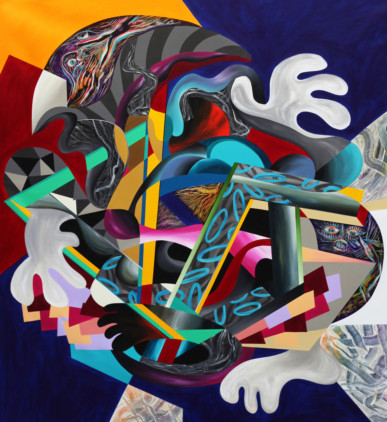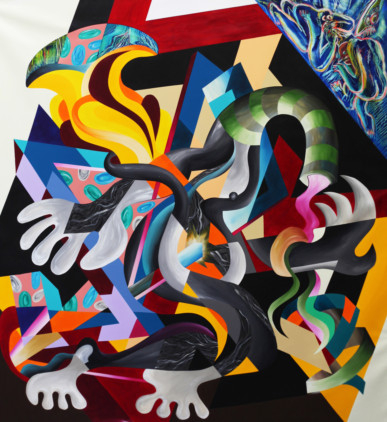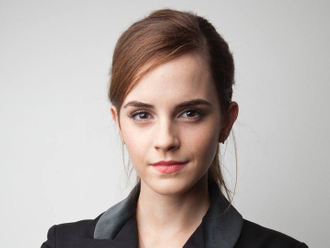
Both are creatures of stealth. Both destroy their prey. Neither have a brain. These descriptions can be applied to two efficient killing machines that outwardly seem to have little in common. One operates in the sky, the other in the ocean. They are the unmanned aerial vehicle or “drone”, and the jellyfish, whose species have roamed the oceans as silent predators for more than 600 million years.
British-Iraqi artist Athier Mousawi has fused these natural and man-made phenomena to create pictures that show the helplessness and despair of the countless, nameless people crushed or enmeshed in war.
The artist spoke about his work at the launch of his latest exhibition, “Man of War”, co-presented with Ayyam Gallery at the Edge of Arabia Gallery in Battersea, London. He said that one of the most insidious aspects of drones was that the act of killing was done remotely, which served to dilute the sense of guilt that the perpetrator might otherwise feel when engaging directly with the target. “With the drone, guilt has been replaced by efficiency on another level,” he commented.
Mousawi’s latest work comprises a series of black-and-white drawings alongside paintings full of vivid colours which at first glance seem to mask the dark elements contained within the imagery. It is only when you step closer that you see the suffering figures with grimacing faces and contorted limbs embedded in the canvas; these, together with images of entrails and blood, are not overt or at the forefront of the paintings — you have to look quite closely to see the disturbing elements in the work. This is deliberate as the artist wants people to be drawn to the paintings.
“You can see the people who become tangled up — figures, bodies and parts of arms — but I always try, especially when using colours, to represent the darker side with more brightness so that it is easier to look at. Even where I have blood cells, I often disguise them with colour. But when you step into the work you realise there is a lot more entrapped inside it,” he explained.
Mousawi has seen at first hand the suffering of people displaced by war. He was the Artist in Residence at the British Museum for three years and has led workshops in refugee camps in Beirut, Istanbul, Amman and Jarash in collaboration with an organisation called START.
Inspired by the UN Human Rights Council’s Declaration of the Rights of the Child, START seeks to heal, educate, and enrich the skills and opportunities of children in the poorest areas of the Middle East through art. With arts education programmes at refugee camps and orphanages throughout Jordan, Lebanon, and Palestine, as well as workshops for children with special needs in the UAE. The non-profit organisation serves today more than 730 children every week and plans to reach more in the near future.
Mousawi worked mostly with Palestinian children in the camps, many of whom were disabled. He emphasised that while the children did not directly affect his work, as he separates his teaching from his practice as an artist, the experience of being in the refugee camps did make a strong impression. “I had quite a direct connection with the people in Sabra, Shateela, Dbeyeh and Burj el Barajneh. I was attached to them. So when you see a drone, you feel it is so inhuman. There is such a sense of detachment,” he said.
It was watching the news on TV of the drone strikes in Gaza in November 2012 in which many civilians were killed that triggered what became an obsessive drive to try and depict the suffering inflicted by such deadly and impersonal weapons. That is when the idea of the drone resembling a jellyfish took hold. He pointed out that neither have “eyes”: when you look at a drone there is no window. Jellyfish, meanwhile, are blind. In that sense both seem horrifyingly oblivious to the damage they inflict.
Mousawi has undoubtedly been affected by the suffering of his homeland, Iraq. Although happily dividing his life as an artist between London, Paris and Istanbul, the years of war and ongoing turmoil have left their mark. There are elements of great tension, sadness, anger and frustration in his work, which perhaps reflect his feelings of despair as he watches events in the Middle East from the standpoint of an exile. He is on record as saying that he is attached to Iraq in a “primal, gravitational way, where I feel my centre is defined by it and my blood is coloured by it”.
A major influence on his development as an artist, he said, was the father of the modern Iraqi art movement, Jawed Selim (1919-1961). Mousawi’s approach can be traced to a respect for the rigidity of bold Arab architecture and the colour and vibrancy of Iraqi painting. He comes from an artistic family; his parents are Ali Mousawi, the architect and the painter, and sculptor Maysaloun Faraj. Mousawi did his MA in Illustration at Central Saint Martins in London. His style has evolved to combine aspects of modernism, architecture and illustration with his strong Iraqi influences.
At the opening of the exhibition several of the guests gave their reactions to the paintings. Iraqi sculptor, Ali Mousawi, who served as a soldier in the 1980/81 Iran-Iraq war and subsequently fled the country, said: “These paintings affect my heart because these things would have happened to me if I had stayed in my country. I left my family behind. I have many brothers, sisters and cousins in Iraq.
“My country has been plagued by war. After the 1980-1981 war which ended in 1987 we started again in 1990, and from 1990 until 2003 the Iraqi people had a very bad situation in the country with no food, medicine or services. Then after 2003 came a new government, but up until now I don’t see any difference.”
The paintings, he observed, were full of the artist’s feelings. “There is a lot of fear and sadness in the paintings.”
Lina Khashogji, an artist from Jeddah, Saudi Arabia, now studying for a PhD in Digital Media at Kingston University in the United Kingdom, said: “There are really strong emotions in each of the paintings. I can feel it from the shapes and the combination of the colours. I really connect with it. I see what is inside the artist from the paintings — the contradictions, some kind of conflict. The background of the artist has really affected his work — it still lives inside of him. It’s very strong and aggressive.”
Ratip Al Sulaiman, who is from Syria, saw the suffering of his countrymen and all people afflicted by war in the paintings. “I think the paintings reflect a lot of things, not just about Iraq, but Syria, the Middle East and the whole world — because the world never rests,” he said. “There has always been war — from the beginning, since Adam and Eve. This is life. The big fish eat the small fish. You can’t avoid these wars.”
He said that for him, the combination of bright, vital colours and the images of suffering locked into the paintings conjured up a battle between the forces of “life and war, fighting and survival”.
Denise Marray is an independent writer based in London.
Mousawi’s work will be on show with Ayyam Gallery at Art Dubai this month.
Sidebar
Athier Mousawi was The National Portrait Gallery’s “Chasing Mirrors” artist-in-residence (2011) and British Museum artist-in-residence (2007-2009). Previous solo exhibitions include: Ayyam Gallery, Beirut (2013), Cuadro Fine Art Gallery, Dubai (2012, 2011); and The Empire Project, Istanbul (2012). Group shows include: Traffic Gallery, Dubai (2012); National Portrait Gallery, London (2011); The Royal Academy, London (2011); Al Mansouriyah Foundation, Paris (2010-2012); and British Museum, London (2007-2009).
Edge of Arabia is an independent arts initiative developing the appreciation of contemporary Arab art and culture. As a social enterprise Edge of Arabia is committed to reaching local and international audiences and improving understanding through free exhibitions, publications, and an international education programme.
Ayyam Gallery represents a roster of Arab and Iranian artists with an international profile and museum presence, such as Abdul Nasser Gharem, Khalid Jarrar, Nadim Karam, Safwan Dahoul, Samia Halaby, Sadik Alfraji, Afshin Pirhashemi and Khalid Takreti. A number of non-commercial exhibitions, as well as the launch of initiatives such as The Young Collectors Auction, have further showcased the work of Middle Eastern artists with the aim of educating a wider audience about the art of the region. Ayyam Gallery Damascus today functions as a studio and creative haven for artists who remain in the war-torn city. In early 2013, Ayyam Gallery launched new spaces in London and Jeddah.













